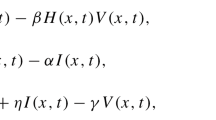Abstract
We introduce an epidemic disease reaction–diffusion model to study the transmission of the varicella-zoster virus in both space and time. More precisely, we present a system of partial differential equations with the Neumann boundary conditions (NBC) concerned to model the evolution of the virus. Firstly, the wellposedness results of the model are studied using the semigroup theory. Then, the boundedness of the solutions is also derived. Further, the basic reproduction number (BRN) for the proposed model is determined using the eigenvalue problem. Moreover, asymptotic profiles of the equilibrium points of the susceptible and infected compartments of the model are investigated. Finally, the advantage of the spatiotemporal model and the above theoretical results are validated with numerical experiments.








Similar content being viewed by others
Data Availability Statement
No data associated with this manuscript.
References
Z. Ahmad, G. Bonanomi, D. di Serafino, F. Giannino, Transmission dynamics and sensitivity analysis of pine wilt disease with asymptomatic carriers via fractal-fractional differential operator of Mittag-Leffler kernel. Appl. Numer. Math. 185, 446–465 (2023)
F. Ayoade, S. Kumar, Varicella zoster (chickenpox), StatPearls (Treasure Island (FL) (2020)
A.W. Blair, W.M. Jamieson, G.H. Smith, Complications and death in chicken-pox. BMJ 2(5468), 981 (1965)
C.E. Rotem, Complications of chicken-pox. BMJ 1(5230), 944 (1961)
A. Suzuki, H. Nishiura, Transmission dynamics of varicella before, during and after the COVID-19 pandemic in Japan: a modelling study. Math. Biosci. Eng. 19(6), 5998–6012 (2022)
M. Wilson, P.J.K. Wilson, Close Encounters of the Microbial Kind: Everything You Need to Know About Common Infections (Springer Nature, Switzerland AG, 2021)
Z. Ali, F. Rabiei, M.M. Rashidi, T. Khodadadi, A fractional-order mathematical model for COVID-19 outbreak with the effect of symptomatic and asymptomatic transmissions. Eur. Phys. J. Plus 137(3), 395 (2022)
N. Bai, R. Xu, Modelling of HIV viral load and 2-LTR dynamics during high active antiretroviral therapy in a heterogeneous environment. Commun. Nonlinear Sci. Numer. Simul. 116, 106874 (2023)
S. Bera, S. Khajanchi, T.K. Roy, Stability analysis of fuzzy HTLV-I infection model: a dynamic approach. J. Appl. Math. Comput. 69(1), 171–199 (2023)
A. Debbouche, J.J. Nieto, D.F.M. Torres, Focus point: cancer and HIV/AIDS dynamics-from optimality to modelling. Eur. Phys. J. Plus 136(2), 165 (2021)
J. Manimaran, L. Shangerganesh, A. Debbouche, J.C. Cortés, A time-fractional HIV infection model with nonlinear diffusion. Results Phys. 25, 104293 (2021)
G. Nazir, K. Shah, A. Debbouche, R.A. Khan, Study of HIV mathematical model under nonsingular kernel type derivative of fractional order. Chaos Solitons Fractals 139, 110095 (2020)
F. Ndaïrou, I. Area, J.J. Nieto, D.F.M. Torres, Mathematical modeling of COVID-19 transmission dynamics with a case study of Wuhan. Chaos Solitons Fractals 135, 109846 (2020)
A. Olivares, E. Staffetti, Robust optimal control of compartmental models in epidemiology: application to the COVID-19 pandemic. Commun. Nonlinear Sci. Numer. Simul. 111, 106509 (2022)
S. Tyagi, S.C. Martha, S. Abbas, A. Debbouche, Mathematical modeling and analysis for controlling the spread of infectious diseases. Chaos Solitons Fractals 144, 110707 (2021)
B.G. Wang, Z.C. Wang, Y. Wu, Y. Xiong, J. Zhang, Z. Ma, A mathematical model reveals the influence of NPIs and vaccination on SARS-CoV-2 Omicron Variant. Nonlinear Dyn. 111(4), 3937–3952 (2023)
S. Edward, D. Kuznetsov, S. Mirau, Modeling and stability analysis for a varicella zoster virus model with vaccination. Appl. Comput. Math. 3(4), 150–162 (2014)
A. Elisha, T. Aboiyar, A.R. Kimbir, Mathematical analysis of varicella zoster virus model. Int. J. Discrete Math. 6(2), 23–37 (2021)
S. Qureshi, A. Yusuf, Modeling chickenpox disease with fractional derivatives: from caputo to atangana-baleanu. Chaos Solitons Fractals 122, 111–118 (2019)
H.L. Smith, H.R. Thieme, Dynamical Systems and Population Persistence, vol. 118 (American Mathematical Society, Providence, 2011)
F.B. Wang, J. Shi, X. Zou, Dynamics of a host-pathogen system on a bounded spatial domain. Commun. Pure Appl. Anal. 14(6), 2535–2560 (2015)
V. Capasso, Global solution for a diffusive nonlinear deterministic epidemic model. SIAM J. Appl. Math. 35(2), 274–284 (1978)
L.J.S. Allen, B.M. Bolker, Y. Lou, A.L. Nevai, Asymptotic profiles of the steady states for an SIS epidemic reaction–diffusion model. Discrete Contin. Dyn. Syst. 21(1), 1–20 (2008)
F.B. Wang, Y. Huang, X. Zou, Global dynamics of a PDE in-host viral model. Appl. Anal. 93(11), 2312–2329 (2014)
H.R. Horst, Spectral bound and reproduction number for infinite-dimensional population structure and time heterogeneity. SIAM J. Appl. Math. 70(1), 188–211 (2009)
P. Magal, X.Q. Zhao, Global attractors and steady states for uniformly persistent dynamical systems. SIAM J. Math. Anal. 37(1), 251–275 (2005)
H.L. Smith, X.Q. Zhao, Robust persistence for semidynamical systems. Nonlinear Anal. Theory Methods Appl. 47(9), 6169–6179 (2001)
A. Pazy, Semigroups of Linear Operators and Applications to Partial Differential Equations (Springer-Verlag, New York, 1983)
W. Desch, W. Schappacher, Linearized stability for nonlinear semigroups, Differential Equations in Banach Spaces: Proceedings of a Conference held in Bologna, July 2?5, 1985, Berlin, Heidelberg: Springer Berlin Heidelberg (2006)
H.L. Smith, Monotone dynamical systems: an introduction to the theory of competitive and cooperative systems, No. 41, American Mathematical Society (1995)
R.H. Martin, H.L. Smith, Abstract functional-differential equations and reaction–diffusion systems. Trans. Am. Math. Soc. 321(1), 1–44 (1990)
P.V. den Driessche, J. Watmough, Reproduction numbers and sub-threshold endemic equilibria for compartmental models of disease transmission. Math. Biosci. 180(1–2), 29–48 (2002)
O. Diekmann, J.A.P. Heesterbeek, J.A.J. Metz, On the definition and the computation of the basic reproduction ratio \(R_0\) in models for infectious diseases in heterogeneous populations. J. Math. Biol. 28, 365–382 (1990)
P. Magal, G.F. Webb, Y. Wu, On the basic reproduction number of reaction–diffusion epidemic models. SIAM J. Appl. Math. 79(1), 284–304 (2019)
W. Wang, X.Q. Zhao, Basic reproduction numbers for reaction–diffusion epidemic models. SIAM J. Appl. Dyn. Syst. 11(4), 1652–1673 (2012)
L.C. Evans, Partial Differential Equations, vol. 19 (American Mathematical Society, Providence, 2022)
J. Wang, W. Wu, T. Kuniya, Global threshold analysis on a diffusive host?pathogen model with hyperinfectivity and nonlinear incidence functions. Math. Comput. Simul. 203, 767–802 (2023)
Author information
Authors and Affiliations
Corresponding author
Rights and permissions
Springer Nature or its licensor (e.g. a society or other partner) holds exclusive rights to this article under a publishing agreement with the author(s) or other rightsholder(s); author self-archiving of the accepted manuscript version of this article is solely governed by the terms of such publishing agreement and applicable law.
About this article
Cite this article
Hariharan, S., Shangerganesh, L., Debbouche, A. et al. Stability analysis of spatiotemporal reaction–diffusion mathematical model incorporating the varicella virus transmission. Eur. Phys. J. Plus 138, 1123 (2023). https://doi.org/10.1140/epjp/s13360-023-04777-6
Received:
Accepted:
Published:
DOI: https://doi.org/10.1140/epjp/s13360-023-04777-6




